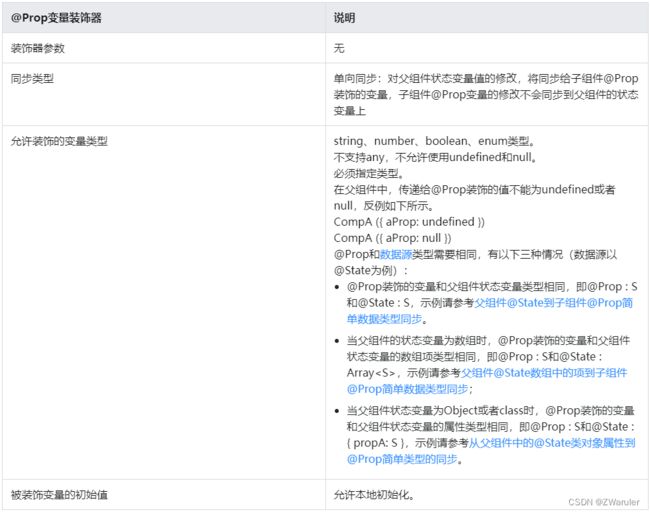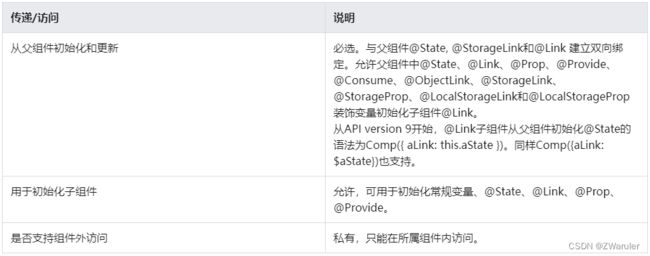鸿蒙开发笔记(五):状态管理,组件状态管理 @State @Prop @Link
如果希望构建一个动态的、有交互的界面,就需要引入“状态”的概念。
在声明式UI编程框架中,UI是程序状态的运行结果,用户构建了一个UI模型,其中应用的运行时的状态是参数。当参数改变时,UI作为返回结果,也将进行对应的改变。这些运行时的状态变化所带来的UI的重新渲染,在ArkUI中统称为状态管理机制。
自定义组件拥有变量,变量必须被装饰器装饰才可以成为状态变量,状态变量的改变会引起UI的渲染刷新。如果不使用状态变量,UI只能在初始化时渲染,后续将不会再刷新。 下图展示了State和View(UI)之间的关系。

- View(UI):UI渲染,一般指自定义组件的build方法和@Builder装饰的方法内的UI描述。
- State:状态,一般指的是装饰器装饰的数据。用户通过触发组件的事件方法,改变状态数据。状态数据的改变,引起UI的重新渲染。
1. 基本概念
- 状态变量:被状态装饰器装饰的变量,改变会引起UI的渲染更新。
- 常规变量:没有状态的变量,通常应用于辅助计算。它的改变永远不会引起UI的刷新。
- 数据源/同步源:状态变量的原始来源,可以同步给不同的状态数据。通常意义为父组件传给子组件的数据。
- 命名参数机制:父组件通过指定参数传递给子组件的状态变量,为父子传递同步参数的主要手段。示例:CompA: ({ aProp: this.aProp })。
- 从父组件初始化:父组件使用命名参数机制,将指定参数传递给子组件。本地初始化的默认值在有父组件传值的情况下,会被覆盖。示例:
@Component
struct MyComponent {
@State count: number = 0;
private increaseBy: number = 1;
build() {
}
}
@Component
struct Parent {
build() {
Column() {
// 从父组件初始化,覆盖本地定义的默认值
MyComponent({ count: 1, increaseBy: 2 })
}
}
}
- 初始化子节点:组件中状态变量可以传递给子组件,初始化子组件对应的状态变量。示例同上。
- 本地初始化:变量声明的时候赋值,作为初始化的默认值。示例:@State count: number = 0。
2. 装饰器总览
ArkUI提供了多种装饰器,通过使用这些装饰器,状态变量不仅可以观察在组件内的改变,还可以在不同组件层级间传递,比如父子组件、跨组件层级,也可以观察全局范围内的变化。根据状态变量的影响范围,将所有的装饰器可以大致分为:
- 管理组件拥有状态的装饰器:组件级别的状态管理,可以观察组件内变化,和不同组件层级的变化,但需要位于同一个组件树上,即同一个页面内。
- 管理应用拥有状态的装饰器:应用级别的状态管理,可以观察不同页面,甚至不同UIAbility的状态变化,是应用内全局的状态管理。
从数据的传递形式和同步类型层面看,装饰器也可分为:
- 只读的单向传递;
- 可变更的双向传递。
图示如下,具体装饰器的介绍,可详见管理组件拥有的状态和管理应用拥有的状态。开发者可以灵活地利用这些能力来实现数据和UI的联动。

上图中,Components部分的装饰器为组件级别的状态管理,Application部分为应用的状态管理。开发者可以通过@StorageLink/@LocalStorageLink和@StorageProp/@LocalStorageProp实现应用和组件状态的双向和单向同步。图中箭头方向为数据同步方向,单箭头为单向同步,双箭头为双向同步。
管理组件拥有的状态,即图中Components级别的状态管理:
- @State:@State装饰的变量拥有其所属组件的状态,可以作为其子组件单向和双向同步的数据源。当其数值改变时,会引起相关组件的渲染刷新。
- @Prop:@Prop装饰的变量可以和父组件建立单向同步关系,@Prop装饰的变量是可变的,但修改不会同步回父组件。
- @Link:@Link装饰的变量和父组件构建双向同步关系的状态变量,父组件会接受来自@Link装饰的变量的修改的同步,父组件的更新也会同步给@Link装饰的变量。
- @Provide/@Consume:@Provide/@Consume装饰的变量用于跨组件层级(多层组件)同步状态变量,可以不需要通过参数命名机制传递,通过alias(别名)或者属性名绑定。
- @Observed:@Observed装饰class,需要观察多层嵌套场景的class需要被@Observed装饰。单独使用@Observed没有任何作用,需要和@ObjectLink、@Prop连用。
- @ObjectLink:@ObjectLink装饰的变量接收@Observed装饰的class的实例,应用于观察多层嵌套场景,和父组件的数据源构建双向同步。
仅@Observed/@ObjectLink可以观察嵌套场景,其他的状态变量仅能观察第一层
管理应用拥有的状态,即图中Application级别的状态管理:
- AppStorage是应用程序中的一个特殊的单例LocalStorage对象,是应用级的数据库,和进程绑定,通过@StorageProp和@StorageLink装饰器可以和组件联动。
- AppStorage是应用状态的“中枢”,需要和组件(UI)交互的数据存入AppStorage,比如持久化数据PersistentStorage和环境变量Environment。UI再通过AppStorage提供的装饰器或者API接口,访问这些数据;
- 框架还提供了LocalStorage,AppStorage是LocalStorage特殊的单例。LocalStorage是应用程序声明的应用状态的内存“数据库”,通常用于页面级的状态共享,通过@LocalStorageProp和@LocalStorageLink装饰器可以和UI联动。
@Watch用于监听状态变量的变化。
$$运算符:给内置组件提供TS变量的引用,使得TS变量和内置组件的内部状态保持同步。
3. 组件状态管理
3.1 @State装饰器:组件内状态
@State装饰的变量,或称为状态变量,一旦变量拥有了状态属性,就和自定义组件的渲染绑定起来。当状态改变时,UI会发生对应的渲染改变。
在状态变量相关装饰器中,@State是最基础的,使变量拥有状态属性的装饰器,它也是大部分状态变量的数据源。
@State装饰的变量,与声明式范式中的其他被装饰变量一样,是私有的,只能从组件内部访问,在声明时必须指定其类型和本地初始化。初始化也可选择使用命名参数机制从父组件完成初始化。
@State装饰的变量拥有以下特点:
- @State装饰的变量与子组件中的@Prop、@Link或@ObjectLink装饰变量之间建立单向或双向数据同步。
- @State装饰的变量生命周期与其所属自定义组件的生命周期相同。
1. 装饰器使用规则说明
2. 变量的传递/访问规则说明
3. 观察变化和行为表现
并不是状态变量的所有更改都会引起UI的刷新,只有可以被框架观察到的修改才会引起UI刷新。
- 当装饰的数据类型为boolean、string、number类型时,可以观察到数值的变化。
// for simple type
@State count: number = 0;
// value changing can be observed
this.count = 1;
- 当装饰的数据类型为class或者Object时,可以观察到自身的赋值的变化,和其属性赋值的变化,即Object.keys(observedObject)返回的所有属性。例子如下。
声明ClassA和Model类。
class ClassA {
public value: string;
constructor(value: string) {
this.value = value;
}
}
class Model {
public value: string;
public name: ClassA;
constructor(value: string, a: ClassA) {
this.value = value;
this.name = a;
}
}
@State装饰的类型是Model
// class类型
@State title: Model = new Model('Hello', new ClassA('World'));
对@State装饰变量的赋值。
// class类型赋值
this.title = new Model('Hi', new ClassA('ArkUI'));
对@State装饰变量的属性赋值。
// class属性的赋值
this.title.value = 'Hi'
嵌套属性的赋值观察不到。
// 嵌套的属性赋值观察不到
this.title.name.value = 'ArkUI'
- 当装饰的对象是array时,可以观察到数组本身的赋值和添加、删除、更新数组的变化。例子如下。
声明ClassA和Model类。
class Model {
public value: number;
constructor(value: number) {
this.value = value;
}
}
@State装饰的对象为Model类型数组时。
@State title: Model[] = [new Model(11), new Model(1)]
数组自身的赋值可以观察到。
this.title = [new Model(2)]
数组项的赋值可以观察到。
this.title[0] = new Model(2)
删除数组项可以观察到。
this.title.pop()
新增数组项可以观察到。
this.title.push(new Model(12))
- 当状态变量被改变时,查询依赖该状态变量的组件;
- 执行依赖该状态变量的组件的更新方法,组件更新渲染;
- 和该状态变量不相关的组件或者UI描述不会发生重新渲染,从而实现页面渲染的按需更新。
4. 使用场景
装饰简单类型的变量
以下示例为@State装饰的简单类型,count被@State装饰成为状态变量,count的改变引起Button组件的刷新:
- 当状态变量count改变时,查询到只有Button组件关联了它;
- 执行Button组件的更新方法,实现按需刷新。
@Entry
@Component
struct MyComponent {
@State count: number = 0;
build() {
Button(`click times: ${this.count}`)
.onClick(() => {
this.count += 1;
})
}
}
装饰class对象类型的变量
自定义组件MyComponent定义了被@State装饰的状态变量count和title,其中title的类型为自定义类Model。如果count或title的值发生变化,则查询MyComponent中使用该状态变量的UI组件,并进行重新渲染。
EntryComponent中有多个MyComponent组件实例,第一个MyComponent内部状态的更改不会影响第二个MyComponent。
class Model {
public value: string;
constructor(value: string) {
this.value = value;
}
}
@Entry
@Component
struct EntryComponent {
build() {
Column() {
// 此处指定的参数都将在初始渲染时覆盖本地定义的默认值,并不是所有的参数都需要从父组件初始化
MyComponent({ count: 1, increaseBy: 2 })
MyComponent({ title: new Model('Hello, World 2'), count: 7 })
}
}
}
@Component
struct MyComponent {
@State title: Model = new Model('Hello World');
@State count: number = 0;
private increaseBy: number = 1;
build() {
Column() {
Text(`${this.title.value}`)
Button(`Click to change title`).onClick(() => {
// @State变量的更新将触发上面的Text组件内容更新
this.title.value = this.title.value === 'Hello ArkUI' ? 'Hello World' : 'Hello ArkUI';
})
Button(`Click to increase count=${this.count}`).onClick(() => {
// @State变量的更新将触发该Button组件的内容更新
this.count += this.increaseBy;
})
}
}
}
从该示例中,我们可以了解到@State变量首次渲染的初始化流程:
- 使用默认的本地初始化:
@State title: Model = new Model('Hello World');
@State count: number = 0;
- 对于@State来说,命名参数机制传递的值并不是必选的,如果没有命名参数传值,则使用本地初始化的默认值:
MyComponent({ count: 1, increaseBy: 2 })
3.2 @Prop装饰器:父子单向同步
@Prop装饰的变量可以和父组件建立单向的同步关系。@Prop装饰的变量是可变的,但是变化不会同步回其父组件。
- @Prop变量允许在本地修改,但修改后的变化不会同步回父组件。
- 当父组件中的数据源更改时,与之相关的@Prop装饰的变量都会自动更新。如果子组件已经在本地修改了@Prop装饰的相关变量值,而在父组件中对应的@State装饰的变量被修改后,子组件本地修改的@Prop装饰的相关变量值将被覆盖。
1. 装饰器使用规则说明
2. 变量的传递/访问规则说明
3. 观察变化和行为表现
观察变化
@Prop装饰的数据可以观察到以下变化。
当装饰的类型是允许的类型,即string、number、boolean、enum类型都可以观察到的赋值变化;
// 简单类型
@Prop count: number;
// 赋值的变化可以被观察到
this.count = 1;
对于@State和@Prop的同步场景:
- 使用父组件中@State变量的值初始化子组件中的@Prop变量。当@State变量变化时,该变量值也会同步更新至@Prop变量。
- @Prop装饰的变量的修改不会影响其数据源@State装饰变量的值。
- 除了@State,数据源也可以用@Link或@Prop装饰,对@Prop的同步机制是相同的。
- 数据源和@Prop变量的类型需要相同。
框架行为
要理解@Prop变量值初始化和更新机制,有必要了解父组件和拥有@Prop变量的子组件初始渲染和更新流程。
-
初始渲染:
a. 执行父组件的build()函数将创建子组件的新实例,将数据源传递给子组件;
b. 初始化子组件@Prop装饰的变量。 -
更新:
a. 子组件@Prop更新时,更新仅停留在当前子组件,不会同步回父组件;
b. 当父组件的数据源更新时,子组件的@Prop装饰的变量将被来自父组件的数据源重置,所有@Prop装饰的本地的修改将被父组件的更新覆盖。
4. 使用场景
父组件@State到子组件@Prop简单数据类型同步
以下示例是@State到子组件@Prop简单数据同步,父组件ParentComponent的状态变量countDownStartValue初始化子组件CountDownComponent中@Prop装饰的count,点击“Try again”,count的修改仅保留在CountDownComponent,不会同步给父组件ParentComponent。
ParentComponent的状态变量countDownStartValue的变化将重置CountDownComponent的count。
@Component
struct CountDownComponent {
@Prop count: number;
costOfOneAttempt: number = 1;
build() {
Column() {
if (this.count > 0) {
Text(`You have ${this.count} Nuggets left`)
} else {
Text('Game over!')
}
// @Prop装饰的变量不会同步给父组件
Button(`Try again`).onClick(() => {
this.count -= this.costOfOneAttempt;
})
}
}
}
@Entry
@Component
struct ParentComponent {
@State countDownStartValue: number = 10;
build() {
Column() {
Text(`Grant ${this.countDownStartValue} nuggets to play.`)
// 父组件的数据源的修改会同步给子组件
Button(`+1 - Nuggets in New Game`).onClick(() => {
this.countDownStartValue += 1;
})
// 父组件的修改会同步给子组件
Button(`-1 - Nuggets in New Game`).onClick(() => {
this.countDownStartValue -= 1;
})
CountDownComponent({ count: this.countDownStartValue, costOfOneAttempt: 2 })
}
}
}
在上面的示例中:
-
CountDownComponent子组件首次创建时其@Prop装饰的count变量将从父组件@State装饰的countDownStartValue变量初始化;
-
按“+1”或“-1”按钮时,父组件的@State装饰的countDownStartValue值会变化,这将触发父组件重新渲染,在父组件重新渲染过程中会刷新使用countDownStartValue状态变量的UI组件并单向同步更新CountDownComponent子组件中的count值;
-
更新count状态变量值也会触发CountDownComponent的重新渲染,在重新渲染过程中,评估使用count状态变量的if语句条件(this.count > 0),并执行true分支中的使用count状态变量的UI组件相关描述来更新Text组件的UI显示;
-
当按下子组件CountDownComponent的“Try again”按钮时,其@Prop变量count将被更改,但是count值的更改不会影响父组件的countDownStartValue值;
-
父组件的countDownStartValue值会变化时,父组件的修改将覆盖掉子组件CountDownComponent中count本地的修改。
父组件@State数组项到子组件@Prop简单数据类型同步
父组件中@State如果装饰的数组,其数组项也可以初始化@Prop。以下示例中父组件Index中@State装饰的数组arr,将其数组项初始化子组件Child中@Prop装饰的value。
@Component
struct Child {
@Prop value: number;
build() {
Text(`${this.value}`)
.fontSize(50)
.onClick(()=>{this.value++})
}
}
@Entry
@Component
struct Index {
@State arr: number[] = [1,2,3];
build() {
Row() {
Column() {
Child({value: this.arr[0]})
Child({value: this.arr[1]})
Child({value: this.arr[2]})
Divider().height(5)
ForEach(this.arr,
item => {
Child({value: item})
},
item => item.toString()
)
Text('replace entire arr')
.fontSize(50)
.onClick(()=>{
// 两个数组都包含项“3”。
this.arr = this.arr[0] == 1 ? [3,4,5] : [1,2,3];
})
}
}
}
}
初始渲染创建6个子组件实例,每个@Prop装饰的变量初始化都在本地拷贝了一份数组项。子组件onclick事件处理程序会更改局部变量值。
假设我们点击了多次,所有变量的本地取值都是“7”。
单击replace entire arr后,屏幕将显示以下信息,为什么?
3
4
5
----
7
4
5
-
在子组件Child中做的所有的修改都不会同步回父组件Index组件,所以即使6个组件显示都为7,但在父组件Index中,this.arr保存的值依旧是[1,2,3]。
-
点击replace entire arr,this.arr[0] == 1成立,将this.arr赋值为[3, 4, 5];
-
因为this.arr[0]已更改,Child({value: this.arr[0]})组件将this.arr[0]更新同步到实例@Prop装饰的变量。Child({value: this.arr[1]})和Child({value: this.arr[2]})的情况也类似。
-
this.arr的更改触发ForEach更新,this.arr更新的前后都有数值为3的数组项:[3, 4, 5] 和[1, 2, 3]。根据diff机制,数组项“3”将被保留,删除“1”和“2”的数组项,添加为“4”和“5”的数组项。这就意味着,数组项“3”的组件不会重新生成,而是将其移动到第一位。所以“3”对应的组件不会更新,此时“3”对应的组件数值为“7”,ForEach最终的渲染结果是“7”,“4”,“5”。
(这操作,真的是认真的吗…这得坑多少人啊,希望能早点改回来!!!)
从父组件中的@State类对象属性到@Prop简单类型的同步
如果图书馆有一本图书和两位用户,每位用户都可以将图书标记为已读,此标记行为不会影响其它读者用户。从代码角度讲,对@Prop图书对象的本地更改不会同步给图书馆组件中的@State图书对象。
class Book {
public title: string;
public pages: number;
public readIt: boolean = false;
constructor(title: string, pages: number) {
this.title = title;
this.pages = pages;
}
}
@Component
struct ReaderComp {
@Prop title: string;
@Prop readIt: boolean;
build() {
Row() {
Text(this.title)
Text(`... ${this.readIt ? 'I have read' : 'I have not read it'}`)
.onClick(() => this.readIt = true)
}
}
}
@Entry
@Component
struct Library {
@State book: Book = new Book('100 secrets of C++', 765);
build() {
Column() {
ReaderComp({ title: this.book.title, readIt: this.book.readIt })
ReaderComp({ title: this.book.title, readIt: this.book.readIt })
}
}
}
@Prop本地初始化不和父组件同步
为了支持@Component装饰的组件复用场景,@Prop支持本地初始化,这样可以让@Prop是否与父组件建立同步关系变得可选。当且仅当@Prop有本地初始化时,从父组件向子组件传递@Prop的数据源才是可选的。
3.3 @Link装饰器:父子双向同步
1. 装饰器使用规则说明
2. 变量的传递/访问规则说明
3. 观察变化和行为表现
观察变化
-
当装饰的数据类型为boolean、string、number类型时,可以同步观察到数值的变化,示例请参考简单类型和类对象类型的@Link。
-
当装饰的数据类型为class或者Object时,可以观察到赋值和属性赋值的变化,即Object.keys(observedObject)返回的所有属性,示例请参考简单类型和类对象类型的@Link。
-
当装饰的对象是array时,可以观察到数组添加、删除、更新数组单元的变化,示例请参考数组类型的@Link。
框架行为
@Link装饰的变量和其所述的自定义组件共享生命周期。
为了了解@Link变量初始化和更新机制,有必要先了解父组件和拥有@Link变量的子组件的关系,初始渲染和双向更新的流程(以父组件为@State为例)。
-
初始渲染:执行父组件的build()函数后将创建子组件的新实例。初始化过程如下:
a. 必须指定父组件中的@State变量,用于初始化子组件的@Link变量。子组件的@Link变量值与其父组件的数据源变量保持同步(双向数据同步)。
b. 父组件的@State状态变量包装类通过构造函数传给子组件,子组件的@Link包装类拿到父组件的@State的状态变量后,将当前@Link包装类this指针注册给父组件的@State变量。 -
@Link的数据源的更新:即父组件中状态变量更新,引起相关子组件的@Link的更新。处理步骤:
a. 通过初始渲染的步骤可知,子组件@Link包装类把当前this指针注册给父组件。父组件@State变量变更后,会遍历更新所有依赖它的系统组件(elementid)和状态变量(比如@Link包装类)。
b. 通知@Link包装类更新后,子组件中所有依赖@Link状态变量的系统组件(elementId)都会被通知更新。以此实现父组件对子组件的状态数据同步。 -
@Link的更新:当子组件中@Link更新后,处理步骤如下(以父组件为@State为例):
a. @Link更新后,调用父组件的@State包装类的set方法,将更新后的数值同步回父组件。
b. 子组件@Link和父组件@State分别遍历依赖的系统组件,进行对应的UI的更新。以此实现子组件@Link同步回父组件@State。
4. 使用场景
简单类型和类对象类型的@Link
class GreenButtonState {
width: number = 0;
constructor(width: number) {
this.width = width;
}
}
@Component
struct GreenButton {
@Link greenButtonState: GreenButtonState;
build() {
Button('Green Button')
.width(this.greenButtonState.width)
.height(150.0)
.backgroundColor('#00ff00')
.onClick(() => {
if (this.greenButtonState.width < 700) {
// 更新class的属性,变化可以被观察到同步回父组件
this.greenButtonState.width += 125;
} else {
// 更新class,变化可以被观察到同步回父组件
this.greenButtonState = new GreenButtonState(100);
}
})
}
}
@Component
struct YellowButton {
@Link yellowButtonState: number;
build() {
Button('Yellow Button')
.width(this.yellowButtonState)
.height(150.0)
.backgroundColor('#ffff00')
.onClick(() => {
// 子组件的简单类型可以同步回父组件
this.yellowButtonState += 50.0;
})
}
}
@Entry
@Component
struct ShufflingContainer {
@State greenButtonState: GreenButtonState = new GreenButtonState(300);
@State yellowButtonProp: number = 100;
build() {
Column() {
// 简单类型从父组件@State向子组件@Link数据同步
Button('Parent View: Set yellowButton')
.onClick(() => {
this.yellowButtonProp = (this.yellowButtonProp < 700) ? this.yellowButtonProp + 100 : 100;
})
// class类型从父组件@State向子组件@Link数据同步
Button('Parent View: Set GreenButton')
.onClick(() => {
this.greenButtonState.width = (this.greenButtonState.width < 700) ? this.greenButtonState.width + 100 : 100;
})
// class类型初始化@Link
GreenButton({ greenButtonState: $greenButtonState })
// 简单类型初始化@Link
YellowButton({ yellowButtonState: $yellowButtonProp })
}
}
}
数组类型的@Link
@Component
struct Child {
@Link items: number[];
build() {
Column() {
Button(`Button1: push`).onClick(() => {
this.items.push(this.items.length + 1);
})
Button(`Button2: replace whole item`).onClick(() => {
this.items = [100, 200, 300];
})
}
}
}
@Entry
@Component
struct Parent {
@State arr: number[] = [1, 2, 3];
build() {
Column() {
Child({ items: $arr })
ForEach(this.arr,
item => {
Text(`${item}`)
},
item => item.toString()
)
}
}
}
ArkUI框架可以观察到数组元素的添加,删除和替换。在该示例中@State和@Link的类型是相同的number[],不允许将@Link定义成number类型(@Link item : number),并在父组件中用@State数组中每个数据项创建子组件。如果要使用这个场景,可以参考@Prop和@Observed。








